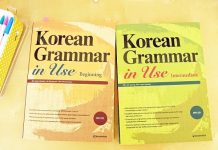가: 저 지하철 입구에 있는 신문을 봐도 돼요?
May we look at that newspaper over at the entrance to the subway?
나: 그럼요, 무료니까 보고 싶은 사람은 아무나 가져 도 돼요.
Sure. It’s free, so anybody who wants to read it can take a copy.
가: 약속 시간이 지났는데 아무도 안 왔어요?
It’s past the appointed time. Has nobody come (yet)?
나: 네, 아무도 안 와서 저 혼자 기다리고 있었어요.
Nope, nobody’s here yet. I’m waiting by myself.
The word ‘아무’ is used to express the not choosing of any specific thing in the sense of “any” (e,g anything, anyone). Depending on the particle that follows it, it can either refer to people or things. To refer to people, the word 아무+나 is used to indicate “anyone” or “anybody”, while 아무+도 is used to indicate “no one” or “nobody”. Note that a negative expression must follow the use of 아무도.
 • 이곳은 입장료만 내면 아무나 들어갈 수 있습니다.
• 이곳은 입장료만 내면 아무나 들어갈 수 있습니다.
Anyone can enter this place as long as you pay the admission fee.
• 아무도 나를 알지 못하는 곳으로 가고 싶어요.
I want to go to a place where nobody knows me.
• 아무거나 사고 싶은 책을 골라 봐.
Choose any book that you want to buy.
1. While the 나 of 아무+(이)나 is also used with interrogative pronouns, such as in 누구+나,어디+나, 무엇+이나, and 언제+나 it sounds awkward to use the 도 of 아무+도with interrogative pronouns in the same way.
• 그 파티에는 아무나 갈 수 있는 거지요?
= 그 파티에는 누구나 갈 수 있는 거지요?
2. A positive expression must come after 아무+(이)나, while a negative expression must come after 아무十도.
가: 뭐 먹을래요?
나: 저는 아무거나 괜찮아요. (〇)
저는 아무것도 먹고 싶지 않아요. (〇)
>> You can click on the title of each grammar below to learn about the other grammar which also expresses ‘Choice’:
01 아무 + (이)나/아무 + 도
02 (이)나
03 (이)라도
04 -든지 -든지
05 -(으)ㄴ/는 대신에
>> Full of Intermediate grammar: Click here



![[Korean grammar] -(으)ㄴ/는 척하다 Expressing Habits and Attitudes](https://sayhikorean.com/wp-content/uploads/2021/10/1_94.1.jpg)
![[Korean grammar] -기는요 Expressing Habits and Attitudes](https://sayhikorean.com/wp-content/uploads/2021/10/1_93.1.jpg)
![[Korean grammar] -곤 하다 Expressing Habits and Attitudes](https://sayhikorean.com/wp-content/uploads/2021/10/1_92.1.jpg)
![[Korean grammar] -았/었어야 했는데 Expressing Regret](https://sayhikorean.com/wp-content/uploads/2021/10/1_91.1.jpg)
![[Korean grammar] -(으)ㄹ걸 그랬다 Expressing Regret](https://sayhikorean.com/wp-content/uploads/2021/10/1_90.1.jpg)
![[Korean grammar] -(으)ㄹ 뻔하다 Expressing Hypothetical Situations](https://sayhikorean.com/wp-content/uploads/2021/10/1_89.1.jpg)
![[Korean grammar] -았/었더라면 Expressing Hypothetical Situations](https://sayhikorean.com/wp-content/uploads/2021/10/1_88.1.jpg)
![[Korean grammar] -(느)ㄴ다면 Expressing Hypothetical Situations](https://sayhikorean.com/wp-content/uploads/2021/10/1_87.1.jpg)
![[Korean grammar] -아/어 봤자 Expressing Futility](https://sayhikorean.com/wp-content/uploads/2021/10/1_86.1.jpg)
![[Korean grammar] -(으)나 마나 Expressing Futility](https://sayhikorean.com/wp-content/uploads/2021/10/1_85.1.jpg)
![[Korean grammar] -고 말다 Expressing Completion](https://sayhikorean.com/wp-content/uploads/2021/10/1_83.1.jpg)